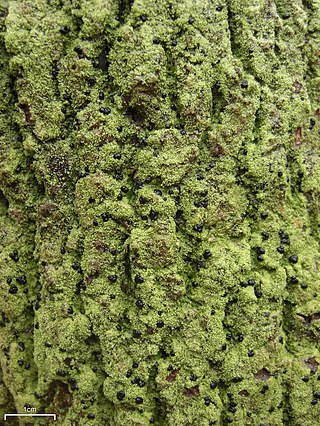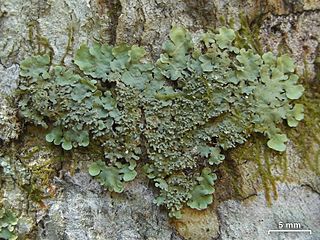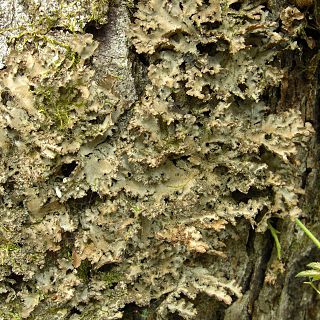
A lichen is a composite organism that arises from algae or cyanobacteria living among filaments of multiple fungi species in a mutualistic relationship. Lichens are important actors in nutrient cycling and act as producers which many higher trophic feeders feed on, such as reindeer, gastropods, nematodes, mites, and springtails. Lichens have properties different from those of their component organisms. They come in many colors, sizes, and forms and are sometimes plant-like, but are not plants. They may have tiny, leafless branches (fruticose); flat leaf-like structures (foliose); grow crust-like, adhering tightly to a surface (substrate) like a thick coat of paint (crustose); have a powder-like appearance (leprose); or other growth forms.

Usnea is a genus of mostly pale grayish-green fruticose lichens that grow like leafless mini-shrubs or tassels anchored on bark or twigs. The genus is in the family Parmeliaceae. It grows all over the world. Members of the genus are commonly called old man's beard, beard lichen, or beard moss.

Peltigera is a genus of approximately 100 species of foliose lichens in the family Peltigeraceae. Commonly known as the dog or pelt lichens, species of Peltigera are often terricolous, but can also occur on moss, trees, rocks, and many other substrates in many parts of the world.

Vulpinic acid is a natural product first found in and important in the symbiosis underlying the biology of lichens. It is a simple methyl ester derivative of its parent compound, pulvinic acid, and a close relative of pulvinone, both of which derive from aromatic amino acids such as phenylalanine via secondary metabolism. The roles of vulpinic acid are not fully established, but may include properties that make it an antifeedant for herbivores. The compound is relatively toxic to mammals.

The Pannariaceae are a family of lichens in the order Peltigerales. Species from this family have a widespread distribution, but are especially prevalent in southern temperate regions.

Bacidia is a genus of lichen-forming fungi in the family Ramalinaceae. The genus was circumscribed by Giuseppe De Notaris in 1846. Species in the genus are crust-like lichens with stemless apothecia; they have green algae (chloroccoid) as photobionts. Their asci have 8 colorless, cylindrical to acicular, multiseptate spores, with curved and thread-like conidia.

Sticta is a genus of lichens in the family Peltigeraceae. The genus has a widespread distribution, especially in tropical areas, and includes about 114 species. These lichens have a leafy appearance, and are colored brown or black. Sticta species with cyanobacteria as photobionts can fix nitrogen from the atmosphere, and due to their relative abundance and high turnover, they contribute appreciably to the rainforest ecosystem. They are commonly called spotted felt lichens.

Pannaria is a genus of lichen-forming fungi in the family Pannariaceae. The widespread genus contains an estimated 51 species, found primarily in tropical regions.

Erioderma is a genus of lichen-forming fungi in the family Pannariaceae. They are commonly called mouse ears or felt lichens, and are small, pale brown to olive-brown foliose cyanolichens with a fuzzy upper surface that have the cyanobacteria Scytonema as their photobiont. Most species are found in the tropics of Central and South America, although three species are found in coastal regions of North America where they generally grow on mossy branches in humid sites. All North American species are rare. Species of Erioderma can resemble Pannaria, Leioderma, or small Peltigera, but their fuzzy upper surface and lack of veins on their lower surface distinguishes them from these lichens.

Punctelia is a genus of foliose lichens belonging to the large family Parmeliaceae. The genus, which contains about 50 species, was segregated from genus Parmelia in 1982. Characteristics that define Punctelia include the presence of hook-like to thread-like conidia, simple rhizines, and point-like pseudocyphellae. It is this last feature that is alluded to in the vernacular names speckled shield lichens or speckleback lichens.

Peltula is a genus of small dark brown to olive or dark gray squamulose lichens that can be saxicolous ) or terricolous. Members of the genus are commonly called rock-olive lichens. They are cyanolichens, with the cyanobacterium photobiont from the genus Anacystis. They are umbilicate with flat to erect squamule lobes that attach from a central holdfast or cluster of rhizenes. Lichen spot tests are usually negative.

Astrothelium is a large genus of corticolous (bark-dwelling) lichens in the family Trypetheliaceae. The genus is characterized by a corticate thallus and diverse ascomata structures, which can be simple, aggregated, or forming pseudostromata. Astrothelium is also notable for the carbonized walls of its ascomata, the so-called textura intricata arrangement of cells in these walls, and various forms of distoseptate, transparent spores.

Malmidea is a genus of crustose lichens and the type genus of the family Malmideaceae. It was established in 2011 to contain a phylogenetically distinct group of species formerly placed in the genus Malcolmiella. Malmidea comprises more than 50 mostly tropical species that grow on bark, although a few grow on leaves.
Sticta emmanueliana is a species of foliose lichen in the family Peltigeraceae. Found in Hawaii, it was described as a new species in 2020 by Bibiana Moncada, Robert Lücking, and H. Thorsten Lumbsch. The specific epithet honours the Belgian lichenologist Emmanuël Sérusiaux, "on the occasion of his official retirement from formal duties".

Coenogonium is a genus of crustose lichens in the monotypic family Coenogoniaceae. It has about 90 species. Most species are leaf-dwelling or grow on bark, although a few are known to grow on rocks under certain conditions, and some are restricted to growth on termite nests. The genus was circumscribed in 1820 by German naturalist Christian Gottfried Ehrenberg.

Emmanuelia is a genus of lichen-forming fungi in the subfamily Lobarioideae of the family Peltigeraceae. It has 12 species. It was circumscribed in 2020 by Antoine Simon, Robert Lücking, and Bernard Goffinet. They assigned Emmanuelia ravenelii as the type species, reasoning "this is probably the best-documented species of the lineage and its identification is straightforward". The genus name honours Belgian lichenologist Emmanuël Sérusiaux, "for his extensive contributions to advancing our understanding of the diversification of the Peltigerales".

The following outline provides an overview of and topical guide to lichens.

Crocodia is a genus of foliose lichens in the family Peltigeraceae. It has eight species. The genus has a cosmopolitan distribution, although most species occur in temperate and tropical regions of the Southern Hemisphere. The main characteristics of the genus that separate it from its parent genus, Pseudocyphellaria, include a yellow medulla and yellow pseudocyphellae on the lower thallus surface.

Pseudocyphellaria argyracea is a species of foliose lichen in the family Peltigeraceae. It was first scientifically described in 1822 by Dominique François Delise. Edvard Vainio transferred it to the genus Pseudocyphellaria in 1898.





















